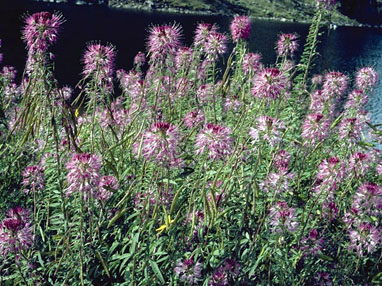Food:
"Spider-flower has an offensive, skunky smell and an alkaline taste, but both are said to disappear when plants are properly prepared. Tender young plants up to a few inches tall (were boiled for a couple of hours or all day. Then the water was discarded and they were boiled in fresh water for an additional 2 hours. Sometimes meat was added to the mixture to make a stew, or the cooked plants were lightly salted and eaten with cornmeal porridge. Cooked plants were also drained and fried, or they were pressed dry (3 times), formed into cakes or small balls and dried for later use. The dried cakes/balls were soaked and then boiled in soups and stews or fried. The young flowers and seed pods were also eaten, and the seeds were ground to make flour. Spider-flower is said to have saved the Navajo from starvation several times. It was considered important enough to be named in songs with the 3 main cultivated plants: corn, pumpkin and cotton."(Kershaw 126)
"Pods are hot and spicy when fresh. Cooking or drying reduces spiciness. Great fresh in salads, homemade salad dressing, salsa, pesto, chip dip, tacos, or lightly cooked in stir-fries. Young sprouts are also edible, but difficult to identify." (Seebeck 19)
"A generation ago, the native New Mexican would under no circumstances destroy the weed -remembering well the story of the great drought in which his ancestors would have starved had they not resorted to tortillas made from the ground seeds of this plant." (Curtin 78)
Medicine:
"The plants were dried, finely ground and mixed in water to make a medicinal teal for treating stomach problems. Also, fresh plants were wrapped in cloth and applied to the abdomen as a poultice."(Kershaw 126)
"Iron always has been a favorite medicine for anemia; and locally a piece of rusty iron is boiled in water with the flowers. The decoction is strained, and the dose is one glassful drunk cold." (Curtin 77)
"The people of Agua Fria have a somewhat different remedy for stomach difficulties: the leaves are plucked very cautiously, care being taken not to crush them. They are boiled in just enough water so a not to be too dry. A handful of corn and three cloves are put in a bag and boiled with the above preparation for three hours, when the sack is removed. The corn takes away the bitter taste, and the leaves can be eaten as greens with remedial results. And as for torson en las tripas (gripes in the intestines), another method is employed: one part of guaco leaves is added to one part of anil del muerto (goldweed- i.e. Crownbeard - Verbesina encelioides), and both are mashed together and mixed with hot water. The resultant liquid is strained, and the decoction drunk." (Curtin 78)
"I was informed at Ciruela that if the leaves area crushed and placed on the swelling, they will reduce inflammation caused by the bites of all poisonous insects." (Curtin 78)
Other Uses:
"Tea, made by boiling a few seeds in water, was given to performers to strengthen their voices and give them 'good blood.' The cooled leaf tea was applied as a body deodorant, and the leaves were placed in shoes and moccasins to reduce odor. Spider-flower was sometimes used for sheep and horse feed. The young plants were used to make black paint for decorating pottery and other items. they were boiled to a thick, black mush and them dried in cakes that kept indefinitely. Later, the cakes were soaked in hot water until they reached the consistency of paint." (Kershaw 126)
"The Tewa, Zuni, and San Ildefonso Pueblo Indians have all found that they can make a black pottery paint for guaco. Although the coloration is obtained by extensive boiling, the Zuni, in contradistinction to the Tewas who use the entire herb, do not decoct the root as well." (Curtin 78)
"It was also the source for black designs on baskets crafted by various pueblos, as at Santa Clara, where most of the tray-type baskets were traditionally ornamented with black-and-red geometrics."(Dunmire and Tierney 184)
